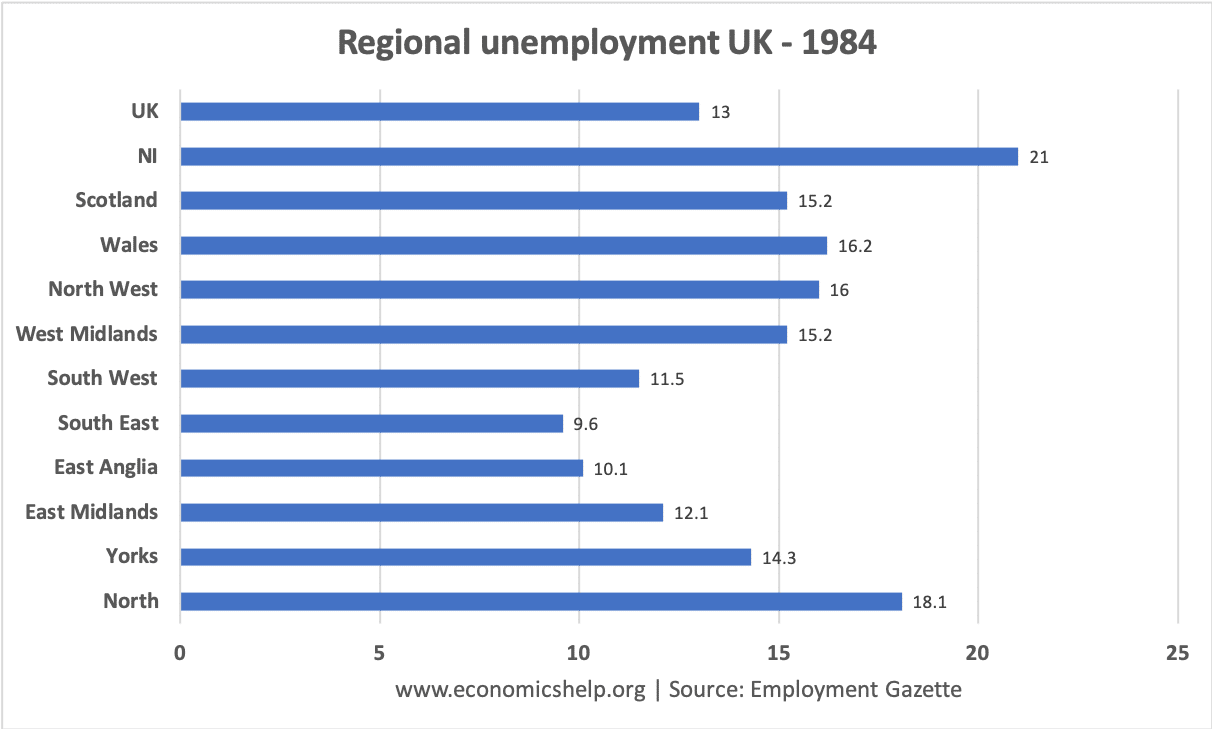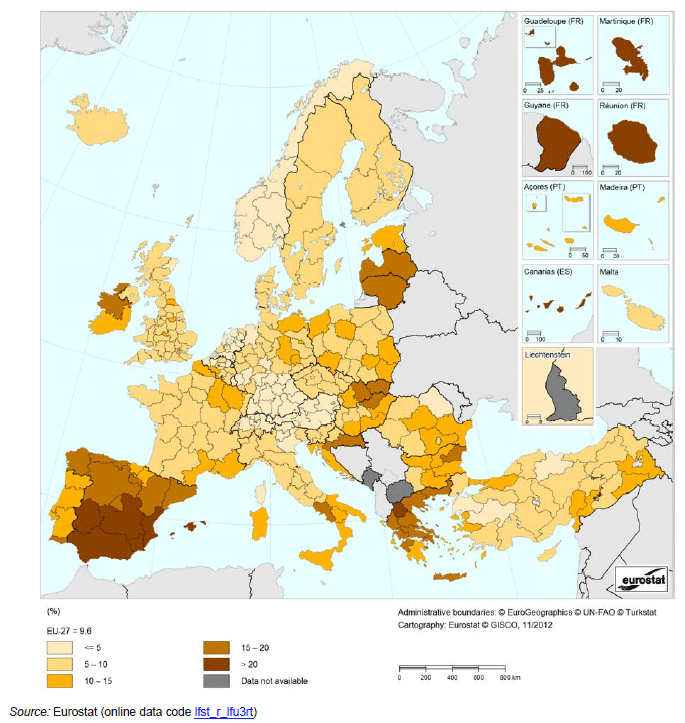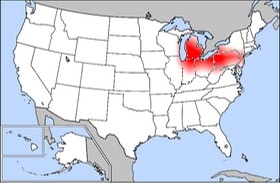Geographical unemployment occurs when people are without work because of immobilities in firms and workers moving to/from depressed regions.
For example, London may have a booming job market with vacancies, however, an unemployed man in south Wales may be unable to take the job because of difficulties in moving to London.
Alternatively, a firm may wish to hire workers but the firm is unable or unwilling to move to areas with surplus labour because it would be the wrong location for the firm.
There are also different types of geographical unemployment
- Divide between different regions – e.g. north vs south
- Local geographical unemployment. This is unemployment within a particular region, e.g. within Greater London, some deprived estates have much higher unemployment than prosperous areas a few miles away.
Reasons for geographical unemployment
- Labour immobility. In theory, labour could move to areas where unemployment is lower. But, in practice, there are many immobilities, which make it difficult for labour to move. For example, an unemployed miner:
- Housing costs. Areas of high employment often have more expensive house prices and renting. Also, when you are unemployed paying more for renting is especially difficult. Therefore, it is very hard to take up new employment elsewhere.
- Family ties. Labour is not like an impersonal factor of production like capital. An unemployed worker may have children at local schools, and many commitments in the local area. All these local commitments create a cost and difficulty of leaving.
- The decline of regional industry. Some areas relied on certain industries to provide a large percentage of local jobs. If these industries close down then areas suffer from a relatively high rate of unemployment. A good example, was when coal mines closed down in South Yorkshire, the northeast and South Wales. It led to high unemployment in these former mining towns.
- Negative multiplier effect. Depressed areas often struggle to attract investment. e.g. if an industry closes down then other related businesses also suffer. For example, cafes, pubs which used to service the old industries will also see a fall in demand. Therefore, the whole region is affected by the closure of a major employer.
- Lack of skills/qualifications. Geographical unemployment is often exacerbated by a lack of skills and flexibility amongst the unemployed. It creates a dual difficulty in moving – uncertainty about whether suitable jobs will be available in other regions. This also explains geographical unemployment within a small area. For example, high unemployment in one borough of London may be related to lower education and skills, rather than the difficulty of moving or travelling to a borough with lower unemployment.
- The unwillingness of firms to move to depressed areas. In theory, if a region has high unemployment, this should put downward pressure on wages and make it more attractive for firms to invest in depressed areas. However.
- Firms need access to local infrastructure, e.g. a finance firm may struggle to attract the right kind of workers if it was based in the north.
- Higher wages and demand in prosperous areas. Many service sector industries, like cafes and restaurants, are highly local. They will set up only in areas where the local demand exists.
- Wages may be sticky downwards. A firm may be committed to paying the same wage in all regions. Therefore, cannot move to depressed areas and pay lower wages.
Examples of Geographical unemployment
Rustbelt US
The Rust-belt in the US is an area of the northeast United States, which used to be a prosperous centre of manufacturing. However, the decline in manufacturing due to shifting comparative advantage (cheaper imports from China) and higher labour costs, led to structural and geographical unemployment in these areas.
UK regional unemployment
In the UK, regional unemployment in 2018 is relatively low by historical standards.
- The highest unemployment rate was in the North East (5.5%)
- The lowest was in the South West and the East of England (both 3.1%). (ONS)
However, back in 1984, UK regional unemployment was a significant problem with unemployment in NI reaching 21%, compared to UK average of 13%

UK regional unemployment in 1984. This was after the 1981 recession which hit hard many of UK manufacturing industries – mostly concentrated in the north. It was a period of high unemployment all over the country (UK average was 13%) However, regional disparities were greater.
EU regional unemployment

The EU single market has high areas of regional unemployment, such as southern Spain, Greece. In theory, the single market allows free movement of workers and capital, but in practice, there are many barriers to moving, such as language, the strength of the local economy and employment opportunities.
Regional unemployment has also been exacerbated by the Euro and divergence in competitiveness that can occur in a single currency with common monetary policy. See: European unemployment crisis
Policies to deal with Geographical unemployment
- More affordable housing. A major problem is cost of housing in prosperous areas. Providing affordable housing is key to attracting workers. This may require the government building more affordable homes (which will take a long time) Or it could try to limit rents. Though maximum prices have their own problem of discouraging supply.
- Moving government agencies. Some major agencies were all based in London. However, over time, many agencies have been moved to more depressed areas. For example, DVLA moved to Swansea, tax office in Shipley, Bradford. The BBC has moved more branches to places like Manchester. The argument is that by investing and moving real jobs to depressed areas, it can create a positive multiplier effect in these areas.
- Tax breaks/subsides to firms who invest in depressed areas. The government has sought to attract new investment in previously depressed areas. For example, the large Toyota factory in Sunderland helped create new jobs after the decline of coal and shipbuilding.
- Geographical subsidies to firms are potentially controversial as there is a cost to the taxpayer, the firm may misuse subsides to maximise profits. Also, they can potentially conflict with Single market rules on unfair competition.
- EU single market and freedom of movement. Allowing free movement of labour across the EU continent can enable workers to have greater opportunities to work elsewhere. For example, in the mid 1980s, many unemployed workers in the northeast took jobs in Germany.
Related

